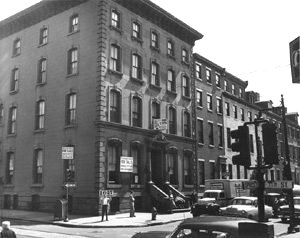
Covering approximately 35 blocks—from 7th Street to Broad Street and Walnut Street to South Street—Washington Square West developed in the early 19th century, as the city expanded west from the Delaware River. Although this downtown neighborhood has a strong residential core with many historic houses, institutions such as Pennsylvania Hospital (the nation's first hospital), Thomas Jefferson University, and Wills Eye Hospital are also located here. Some small-scale industrial properties developed during the period in which this part of the city was originally settled. However, most of these properties were eventually converted to residential use (for example, the Macar Building on 11th Street below Locust Street, now an apartment building) or demolished (for example, the former site of the Clinton Envelope factory at the northwest corner of 10th and Lombard streets, now the site of a townhouse development).
During the early decades of the 20th century, many of the area's large single-family houses were converted into apartments and rooming units, and several mid-rise hotels were constructed on small sites. By mid-century, Locust Street, a "transition" area where downtown retail uses to the north converged with the predominantly residential community to the south, had gained a reputation as a seedy entertainment zone. Bars and night spots such as the ominously-named Bucket of Blood (once located near the intersection of 13th and Locust streets) attracted pleasure-seekers, including many sailors from the Philadelphia port and the naval base. The proliferation of poorly-maintained rooming units, which housed a large transient population, undermined the stability of once-elegant blocks on Spruce Street and elsewhere in Washington Square West.
Despite these problems, many well cared for, appealing residential blocks remained stable, and some were upgraded through private investment in the years following World War II. Renowned architect Louis I. Kahn lived on historic Clinton Street (a nearby park at 11th and Pine streets bears his name). Philadelphia Orchestra conductor Eugene Ormandy lived on Addison Walkway—a very narrow, brick-paved street, a portion of which has been removed from the city grid and reserved for pedestrians only. The houses on Addison are essentially new construction in traditional styles.
Most vacant and badly
deteriorated property in the area was developed or upgraded as the result
of government redevelopment programs and private investment during the
1970s and 1980s. Although the neighborhood possesses fewer amenities and
a less elegant overall appearance than Society Hill, Washington Square
West's downtown location, attractive residential blocks, and diverse mix
of housing types make it one of the region's most interesting communities.
![]()
![]()

Northeast corner of 11th and Spruce Streets, 1958.
TOP • NEXT PAGE • LIST OF TOUR STOPS • MAP • P.N.R.T. HOME • YOUR COMMENTS